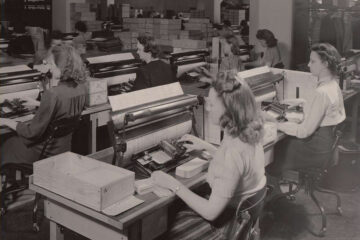Most everybody loves new toys, and it’s not often that you get to try out a new kind of toy. This morning I test drove the new Apple Vision Pro, so I thought I’d add my thousand words to the millions being written about it today.
The timing of the drop-off line at school put me at the Apple Store just before opening. People weren’t queued around the block, but at the top of the hour about a half-dozen people popped out of their cars and in the front door. Pick-ups to the right. Demos to the left.
I got checked in. The pick-ups were served first, but the store was so well-staffed it only took a couple minutes for a very nice saleswoman with lots of tattoos and face jewelry to invite me to sit at an empty table off to the side. Safety reasons.
I got the first demo of the day, and I was her first “live” demo. She sat around the corner of the table and finished the preliminaries: face scans, a briefing on the basics, and some mild probing about my interest in buying one today. When all of the data was collected the message was sent to the back room.
The “spatial computer” appeared from around the corner, carried on a tray like an English butler. It was presented front-forward on the table in front of us. I’d bet that the presentation was an intentional part of the experience.
My first impression was astonishment at how small it was for the number of cameras and computer chips and everything built into it.
Before you put it on, you’re shown to to pick it up. Thumb on the bottom through where the nose goes, remaining fingers grasp the top, and the other hand pulls the strap around the back of your head.
It’s very important that you get the headset properly adjusted for tightness around your forehead, and positioned for height on your cheeks.
In the excitement it’s easy to charge ahead when it’s not sitting just right. Like I did. And then you end up having to re-calibrate it later when you get it on more comfortably.
Here goes. On my face. And the first thing I see is everything I was seeing before I put it on. The illusion of seeing through it is amazing. There was a little motion blur when I turned my head, but it resolved quickly. I’m susceptible to motion sickness. I’ve tried several virtual reality headsets and I haven’t been able to use them for more than a couple of minutes.
The home screen is suspended in the room in front of you. You turn your head and it stays put. Click the digital crown on the top of the headset and it jumps to where you’re looking. When you look at an icon, it “comes to life.” The eye-movement tracking, once calibrated, works well and becomes intuitive quickly. Tap your forefinger and thumb to select. It feels weird at first, but not for long. Mainly you want to poke at the icons in front of you like your phone. Open applications can be resized and zoomed in three dimensions, bringing them closer or moving them farther away. The spatial illusions are extremely good.
The saleswoman took me through the demo: practicing looking at stuff (yes, looking at stuff takes a little practice), selecting, zooming, and scrolling. The demo includes regular photos, panoramic photos that extend across your entire field of vision, and an “immersive experience” that feels truly immersive. The Apple Store showroom disappeared completely into a mountaintop and then a seashore.
The next part of the demo was 3-D. The still photos reminded me of looking through a ViewMaster, and the 3-D video was amazing. It really feels like you’re there at the birthday party or on the edge of the cliff or at the baseball game. Some scenes make you reflexively jump back out of the way and the animals seem both real enough and close enough to pet. The spatial sound adds to the illusion even without ear buds or headphones. The whole demo took about 25 minutes. To summarize:
- The immersive experience is amazing, both sight and sound.
- The controls work well and are intuitive once you learn them and practice them a little.
- The images are clear and the text (like on web pages) is easy to read. You don’t feel like you’re looking at a pair of computer monitors mounted in front of your eyeballs.
- For those of us who get motion sick, I didn’t notice any motion blur when I moved my head while looking at applications, panoramic photographs, or the immersive experience.
The Cons:
- For those of us who get motion sick, I noticed a little motion blur when I moved my head while looking at the room around me.
- The headset felt heavy on my forehead and I was ready to take it off at the end of the demo. Maybe it still wasn’t adjusted right and a second strap that goes over the top of the head is also available. I would want to be sure that I could adjust it so that it could be worn longer.
- I think I would still want to use a keyboard for writing.
- I’m not sure that I would use it enough to justify the $3499 price tag. To put that into perspective, though: I bought my first Macintosh, a Mac Plus, in 1988 for $1799 (using the student discount). That would be about $4600 today.
The Bottom Line:
The Apple Vision Pro seems like it would be perfect for someone who lives in a small apartment or who travels a lot. Bonus if it can be taken as a business expense. It really would be like watching a movie on the big-screen while sitting in an airplane or taking your large monitor with you into the hotel room. It could also provide an enormous quality of life improvement for quadriplegics or others with muscular control challenges, as well as the bed-bound. And, of course, gamers.
If you have the opportunity, I would highly recommend trying it, especially if you haven’t used a virtual reality headset before. It is a unique experience and a great new toy.


